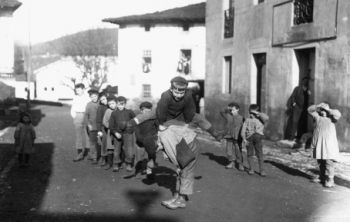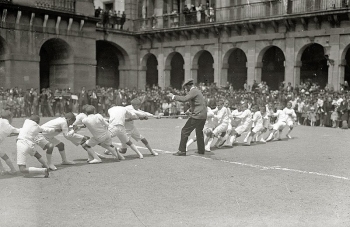Customs and games
- 14/ 11/ 2001
From the time they are born, boys and girls begin to learn the roles they are to play in their adult lives. These roles have traditionally been learned through play, as well as through more rational or reasoned explanations. Attending entertainment organised by adults enables children to enter the adult world. Language, manual skills, capacity for observation and the ability to solve problems are also learned from birth. Many childhood games and behaviour patterns that live on into adult life still bear the mark of youth.

A look at the Atlas Etnográfico de Vasconia (1) ("Basque Ethnographic Atlas") shows the wide range of skills which the boys and girls of Bizkaia learn in childhood. There are tricks to get babies to eat and games involving physical contact which fall in with the guidelines of traditional teachings on the importance of touching and hugging for new-born babies. Babies gradually become aware of their mobility, and reaffirm it through songs and games in which they turn their wrists from side to side or up and down.
Once they have mastered the technique of moving one hand in any direction, babies begin to learn how to co-ordinate both hands by turning their wrists in and out and making other similar movements, accompanied by music and sometimes by simple songs. More attention is required to learn how to clap hands. This movement is also reinforced through songs and games. Once the hands are mastered the next stage involves the arms, which enter children's folklore with the pleasures of rocking and the associated music, which enables infants to repeat actions without being close to a parent or teacher.
Over this period a repertoire of lullabies is built up to calm the baby and help them sleep. Once children have control of their upper limbs they start working on their lower ones, with new games involving trotting, jumping, hopping and other movements aimed at reaffirming leg movement. This also entails moving their hips.
In the early months, body movement is the most important thing, but language then gradually starts to take on an increasingly important role. The repetition of songs, which so far has been used mainly to reinforce movements, now takes on a new function. Riddles, songs involving the repetition of strings of words, inversions of word order and invented languages in which, for instance, a particular sound is inserted among the syllables of every word, are just a few examples. Under this heading we can group the formulae used by children when distributing things or selecting team members.
The concept of group membership brings with it the concept of competition. Races, which started out individually, now become group activities, and maintain that status as children grow older. Sack races, three-legged races and tag games increase children's motor activity and gregariousness. After racing, or together with it, jumping becomes increasingly important. This, together with group awareness, leads to various competitions: hopping races, sack races and leaping over other groups are just some examples of this. The manual dexterity acquired is reflected as rivalry in throwing objects over a fixed or unlimited distance, i.e. seeing who can throw sticks, stones, bottle-tops, etc. furthest in terms of height or distance. Situations such as these are manifested throughout youth.

Tug-of-war is a competition between two groups pulling on opposite ends of a rope in which each group tries to move the other. It is a regular event at public festivities. Mastery of finger movement is developed through games with marbles, bottle-tops and other objects which call for not only throwing skill but also the ability to calculate force and accuracy - which are useful skills for hunting. Spinning tops involves the same abilities, as does cat's cradle, in which figures are formed by intertwining a length of string around the fingers.
There are two other types of game which reinforce skills in hiding and finding. On the one hand we have games in which one group must find objects hidden by another, or must find the group itself, and o the other there is the search for the unknown, typified by hunting for crickets, grasshoppers, dragonflies or other insects. Those who hide have to learn the safest, least accessible places, etc. Games played blindfolded must be included in this category. Imitation of animals or of activities in society takes various forms, from direct imitation of movements and sounds to playing out adult roles. Skill in weaponry - which is fundamental in a farming and cattle-raising society - is gradually acquired with catapults, bows, slings and pea-shooters. Board games and particularly card games develop skills involving strategies. We shall not describe these games further here: readers interested in more details should consult the work mentioned above.
After childhood and adolescence, which can be considered as an intermediate step towards adulthood, comes youth. At this stage the games of agility developed earlier are recreated, and new games also appear. We are looking here at a farming society, so the prospect facing young people is that of farm work, an area which provides a very limited number of objects which can be used. Those living on the coast learn to swim, and compete with their peers in swimming races. But coastal dwellers must also learn to sail, and this opens up the possibility of sailing and rowing races. Thirdly, fishermen compete to bring home their catch before their rivals and thus set its price. This has led along the coast of Bizkaia, and indeed all along the Bay of Biscay coast, to races in launches and open boats originally used to bring fish home. Nowadays this is a sport.
People living inland (and indeed elsewhere) need several abilities:
a) strength, which is acquired by carrying heavy weights (txingas) or throwing them far or high (as in the case of caber tossing in Scotland, Australia and elsewhere);
b) skill with sticks, clubs or, in mining areas, the iron bars used to prepare bore-holes (palankari), all of which involve physical exercise;
c) skill in farm animal husbandry (Idi-Probak, Asto-Probak, Zaldi-Probak, etc.);
d) courage and skill in driving untamed cattle - which gave rise to bullfighting, records of which date back at least to the 16th century;
e) skills in other areas of work required on a farmstead in Bizkaia (cutting down trees as quickly as possible, grass-cutting, etc.). This gave rise to the Aizkoraliak, Segalariak, Harrijasotzaileak and other similar sportsmen;
f) control over drink, shown by dancing the txakolin (a one-man dance performed on two gerriko or crossed sashes, or in the absence of sashes on two crossed sticks, in which the dancer leaps from one quadrant to another without touching the cross);
g) mastery of other farm implements, which gave rise to Medieval "greasy pole" competitions;
h) mastery of the dogs used in farm work was also highly valued, giving rise to sheep-dog trials at which shepherds showed off their skill at training their dogs.
Finally, let us consider the entertainments and dances which may have originated out of people's need to show off individual skills to find a spouse. Another major recreational activity among rural people has traditionally been betting on cock-fights and battles between rams. A local version of bowling was also traditionally very popular in Bizkaia, and old bowling alleys can still be seen beside many village churches. Bets were laid on the game, which had many variants but basically consisted of throwing a single bowling ball and knocking down a number of poles or skittles in one or more turns. Some analysis argue, on the basis of the proximity of these bowling alleys to churches, that the game is based on some kind of ritual to do with the sun, but there is not enough evidence for this to be confirmed.
And finally there is the game of pelota, usually played on a court known as a frontón with a front and side wall at right angles to each other. In former times it was often played in church porches. There are many variants of the game which involve different rules and different courts: sometimes there is just one angle, sometimes an enclosed, four-wall court is used and sometimes irregular surfaces are included to make the bounce of the ball more difficult to judge. The ball many be struck with the bare hand, with a short or wide bat, or with any one of a number of basket-like devices attached to the player's arm. Pelota and bowls are the most widely known sports which have their roots in our area.
(1) Various authors. Atlas Etnográfico de Vasconia. Juegos Infantiles en Vasconia. Eusko Jaurlaritza. Bilbao. 1993. AGUIRRE FRANCO, Rafael, Deporte Rural Vasco. Ed. Txertoa. San Sebastián. 1983.







